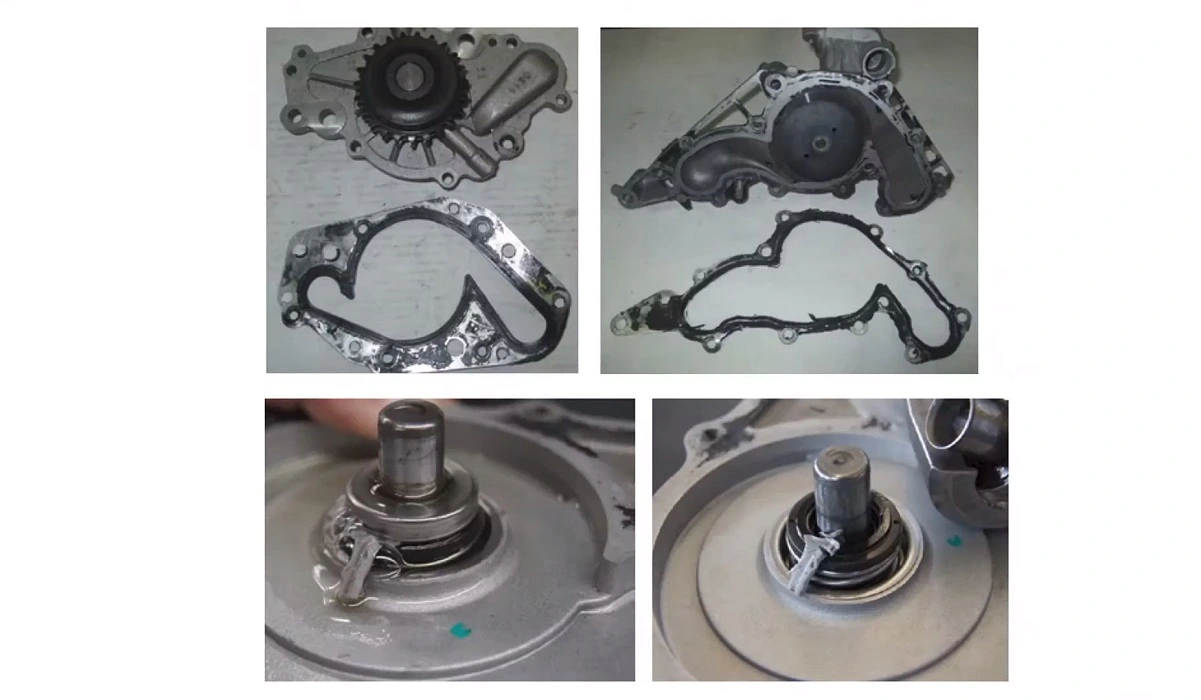Like a humble guardian, the water pump gasket silently seals the heart of an engine, ensuring the lifeblood of coolant flows smoothly, warding off the fiery forces of overheating. In its unassuming presence lies the power to keep the mechanical symphony in perfect harmony, reminding us that even the smallest of parts can play an instrumental role in preserving the grand symphony of machinery.”
In today’s world, knowing how to do a few maintenance tasks on your vehicle is a must. Knowing what to do for engine maintenance isn’t always easy. This article will help you understand the importance of water pump-gaskets and provide you with a few tasks.
What is a Water Pump Gasket?
It’s the part of your engine that seals the outside edge to ensure that no oil, coolant, or other fluid leaks out. The water pump gasket can also be called an O-ring. Since this seal is so important, it needs to be replaced if it becomes damaged or worn. A new water pump-gasket will keep the fluids inside and protect them from contamination by dirt and debris!
Without a properly functioning water pump gasket, coolant leaks can occur, leading to coolant loss, engine overheating, and potential damage to critical engine components. Therefore, ensuring the integrity of the water pump gasket is essential for the overall performance and longevity of an engine.
Water pump gaskets are typically made from durable materials such as rubber, silicone, or composite materials that can withstand the high temperatures and pressures encountered in the engine. They are designed to create a tight, reliable seal that prevents coolant from escaping and contaminants from entering the engine.
Definition: A water pump gasket is a thin, flat, and flexible sealing component that is placed between the water pump and the engine block. It is designed to create a secure and leak-proof seal between these two components, preventing coolant from escaping and maintaining the integrity of the engine’s cooling system.
Function: The primary function of a water pump gasket is to ensure a tight seal between the water pump and the engine block. It provides a barrier that prevents coolant leaks, which are crucial for the proper functioning of the engine’s cooling system. The gasket forms a seal that keeps coolant contained within the system, allowing it to flow efficiently through the engine to regulate and dissipate heat.
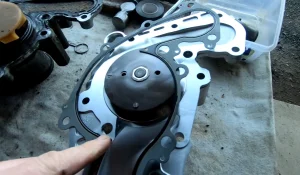
Water Pump Gasket Materials
Water pump gaskets are typically made from various materials that are chosen for their durability, flexibility, and ability to withstand the high temperatures and pressures encountered in the engine cooling system. Common materials used for water pump gaskets include:
Rubber: Rubber is a popular choice for water pump gaskets due to its flexibility, excellent sealing properties, and resistance to coolant and oil. It can provide a reliable seal and withstand the demanding conditions of the engine cooling system.
Paper: Some water pump gaskets are made from paper or cellulose-based materials. These gaskets are typically coated or impregnated with a sealing compound. They offer good sealing capabilities and are often used for specific engine applications.
Composite Materials: Certain water pump gaskets are made from composite materials, which are a combination of different materials, such as rubber, fiber, and metal. These gaskets provide a balance of strength, flexibility, and sealing properties.
Silicone: Silicone-based gaskets are known for their excellent resistance to high temperatures and chemicals. They are often used in performance or high-heat applications where greater durability is required.
Top 5 Water Pump Gasket Pros and Cons
- Fel-Pro: Fel pro water pump gasket is a renowned brand known for its wide range of automotive gaskets, including water pump gaskets. They are known for their quality and durability.
- Victor Reinz: Victor Reinz is another reputable manufacturer that produces a variety of gaskets, including water pump gaskets. They are known for their high-quality materials and precision engineering.
- MAHLE: MAHLE is a global supplier of automotive components, including gaskets. They offer a range of gaskets designed to meet OEM standards, including water pump gaskets.
- ACDelco: ACDelco is a trusted brand that provides a comprehensive range of automotive parts, including gaskets. They offer water pump gaskets designed for various vehicle makes and models.
- Gates: Gates is a well-known manufacturer that produces a wide range of automotive components, including gaskets. They offer reliable water pump gaskets that meet or exceed industry standards.
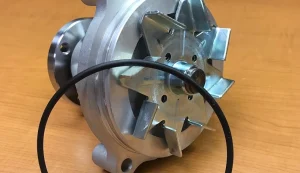
Water Pump Gaskets Price
water pump gaskets typically range in price from around $5 to $50 USD. However, it’s important to note that these prices are approximate and can vary significantly. It is recommended to check with local auto parts stores, online retailers, or authorized dealerships for your specific vehicle.
Lower-priced water pump gaskets are often aftermarket options, while higher-priced gaskets may be OEM (Original Equipment Manufacturer) or premium aftermarket brands. OEM gaskets, which are manufactured by the vehicle’s original manufacturer, tend to be more expensive than aftermarket alternatives.
Choosing The Right Water Pump Gasket
Choosing the right water pump gasket is crucial to ensure a proper seal and prevent coolant leaks in your engine’s cooling system. Here are some factors to consider when selecting a water pump gasket:
- Compatibility: Check the compatibility of the gasket with your specific vehicle make, model, and engine. Ensure that the gasket is designed to fit your water pump and engine block properly. Consult the vehicle’s manual or consult with a trusted mechanic to determine the correct gasket size and specifications.
- Material: Consider the material used in the gasket. Common materials include rubber, paper, composite, and silicone. Choose a material that is compatible with your engine’s cooling system, can withstand the temperature and pressure requirements, and offers good sealing properties.
- Quality: Opt for gaskets from reputable brands known for their quality and reliability. Look for gaskets that meet or exceed OEM standards to ensure a proper fit and sealing performance.
- Application: Determine the specific application of the gasket. Some gaskets may be designed for specific engine types, such as performance engines or engines with unique cooling system configurations. Ensure that the gasket is suitable for your engine’s requirements.
- Budget: Consider your budget when selecting a gasket. While it’s important to choose a gasket of good quality, you should also evaluate different brands and options to find a balance between quality and cost-effectiveness.
- Reviews and Recommendations: Read customer reviews and seek recommendations from trusted sources, such as mechanics or automotive enthusiasts, to get insights into the performance and reliability of different gasket options.
Remember, it’s always advisable to consult with a professional mechanic or refer to the vehicle’s manual for specific guidance on selecting the right water pump gasket for your vehicle.
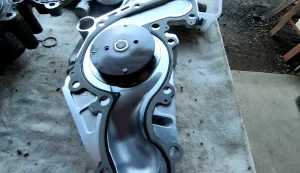
What is a Water Pump Gasket Diagram?
A water pump gasket diagram represents the layout and placement of the gasket about the water pump and engine components. While I can’t provide visual diagrams as a text-based AI, I can describe the general components and their positions about the water pump gasket:
- Water Pump: The water pump is a mechanical device that circulates coolant throughout the engine’s cooling system.
- Engine Block: The engine block is the main structural component of the engine and houses various internal components.
- Water Pump Gasket: The water pump gasket is a sealing component placed between the water pump and the engine block. It ensures a proper seal, preventing coolant leaks.
The diagram would typically show the water pump gasket placed between the water pump and the engine block, forming a seal. The gasket would have openings or holes that align with corresponding openings on the water pump and engine block to allow coolant flow.
It’s important to note that the specific design and configuration of the water pump gasket can vary depending on the engine model and manufacturer. These diagrams are often found in repair manuals or can be obtained from automotive part suppliers or manufacturers for specific vehicles.
Signs of a Failing Water Pump Gasket
Common Symptoms of a Worn or Damaged Gasket
A worn or damaged water pump gasket can exhibit several symptoms that indicate its need for replacement. Here are some common signs to watch out for:
Coolant Leaks: One of the most noticeable symptoms is the presence of coolant leaks. You may observe coolant pooling underneath the engine or notice a decrease in coolant levels without any apparent external leaks. Leaks can occur at the water pump gasket itself or the junction between the water pump and the engine block.
Overheating Engine: A failing water pump gasket can lead to inadequate coolant circulation, resulting in engine overheating. If you notice your engine temperature gauge consistently rising above normal operating levels or if the engine temperature warning light illuminates, it could be an indication of a gasket issue.
Visible Gasket Damage: Inspect the water pump gasket for visible signs of wear or damage. This can include cracks, tears, brittleness, or deformation. If the gasket appears worn or deteriorated, it is likely in need of replacement.
Coolant Contamination: A compromised gasket can allow coolant to mix with other engine fluids, such as oil or transmission fluid. The presence of a milky substance in the oil or frothy residue on the underside of the oil filler cap can be indicative of coolant contamination.
Air Bubbles in Coolant: When the gasket fails, air can enter the cooling system, leading to the formation of air pockets or bubbles in the coolant reservoir or radiator. These air bubbles can interfere with proper coolant flow and contribute to cooling system inefficiency.
Engine Misfire or Poor Performance: In some cases, a failing water pump gasket can cause coolant to leak into the engine cylinders, resulting in a misfire, rough idling, or a noticeable decrease in engine performance.
If you experience any of these symptoms, it is advisable to have your water pump gasket inspected and replaced if necessary to prevent further damage to the engine and ensure proper cooling system function.
Effects of a Failing Gasket on Engine Performance
A failing water pump gasket can have several negative effects on engine performance. Here are some key ways in which a deteriorating or faulty gasket can impact the engine:
Coolant Loss: A failing gasket can lead to coolant leaks, resulting in the loss of coolant from the engine’s cooling system. Insufficient coolant levels can cause the engine to overheat, as there isn’t enough coolant to effectively dissipate heat from the engine components.
Engine Overheating: When a water pump gasket fails to create a proper seal, coolant can escape from the cooling system. This leads to reduced coolant circulation and compromised heat dissipation. As a result, the engine’s temperature can rise to unsafe levels, leading to overheating. Engine overheating can cause significant damage, including warped cylinder heads, blown head gaskets, and even engine seizures.
Poor Engine Cooling: A deteriorating gasket can disrupt the flow of coolant within the engine cooling system. Insufficient coolant flow can prevent the engine from maintaining optimal operating temperatures, leading to decreased cooling efficiency. This can result in reduced engine performance, increased wear on engine components, and potential damage.
Increased Friction and Wear: Insufficient cooling due to a failing gasket can result in increased friction and heat buildup within the engine. This can accelerate wear on vital engine components such as pistons, cylinders, and bearings. Over time, this increased friction can lead to reduced engine performance, loss of power, and increased risk of engine failure.
Engine Misfire or Reduced Power: Coolant leaks caused by a failing gasket may allow coolant to enter the engine cylinders. This can result in a misfire, rough idle, or a noticeable decrease in engine power and responsiveness. Coolant in the combustion chamber can disrupt the air-fuel mixture and hinder proper combustion, leading to impaired engine performance.
It’s important to address a failing water pump gasket promptly to prevent these detrimental effects on engine performance.
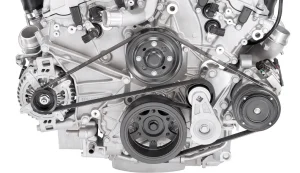
Diagnostic Process of Failing Gasket
To identify a potential water pump gasket issue, you can follow these steps:
Visual Inspection: Begin by visually inspecting the engine bay and the area around the water pump. Look for any signs of coolant leaks, such as puddles or stains on the ground, engine components, or the water pump itself. Note any visible signs of coolant residue or wetness.
Coolant Level Check: Verify the coolant level in the coolant reservoir or radiator. If the coolant level has significantly dropped without any obvious leaks, it could indicate a water pump gasket problem. Low coolant levels can lead to engine overheating and are often a result of coolant leaks.
Coolant Analysis: Check the appearance of the coolant. If the coolant appears milky or frothy, it could be an indication of coolant contamination, which may suggest a failing water pump gasket. Coolant mixing with oil or other engine fluids can occur when the gasket fails, compromising the integrity of the cooling system.
Pressure Test: Perform a cooling system pressure test. This involves using a pressure tester to pressurize the cooling system and checking for any pressure loss. If the system cannot hold pressure or if pressure drops rapidly, it may indicate a coolant leak, potentially caused by a faulty water pump gasket.
System Inspection: Inspect the water pump area and the gasket itself for any visible signs of damage or wear. Look for cracks, tears, or brittleness in the gasket material. Additionally, check for any signs of coolant residue around the gasket or signs of coolant seepage.
Professional Diagnosis: If you are unable to determine the cause of the issue or if you suspect a water pump gasket problem but are uncertain, it is advisable to seek the assistance of a qualified mechanic. They can perform a thorough inspection, utilize diagnostic tools, and provide an accurate assessment of the water pump gasket condition.
When you are diagnosing a water pump gasket issue requires careful observation and analysis. If you suspect a problem, it’s essential to address it promptly to prevent further damage to the engine and cooling system.
What is The Difference Between a Small Leak and a Major Leak?
A small leak can sometimes be fixed with a simple tightening of the water pump bolts. A major leak will require the replacement of the gasket altogether. Water leaks from the coolant and causes an overflow into the engine. This causes the engine to overheat, and the radiator has to work overtime to defend it from damage due to overworked components. The water and antifreeze mix cause corrosion and rust, which will destroy your engine.
Water Pump Gasket Frequently Ask Question
Can I Just Replace The Water Pump Gasket?
Yes, in most cases, you can replace the water pump gasket without having to replace the entire water pump itself. Replacing the gasket involves removing the water pump, cleaning the mating surfaces, and installing a new gasket before reattaching the water pump.
How Do I Know if My Water Pump Gasket is Bad?
Coolant leakage, overheating, or visible damage to the gasket.
Do You Put Sealant on Water Pump Gaskets?
In most cases, sealant is not required for water pump gaskets.
What Kind of Sealant to Use on Water Pump Gasket?
Typically, no sealant is required for water pump gaskets. Sealants are generally not necessary or recommended. Most water pump gaskets are designed to provide a proper seal without the need for additional sealants.
Should I Use RTV Sealant on Water Pump Gasket?
It is generally not necessary to use RTV sealant on a water pump gasket.
Conclusion
If you’re having trouble with your water pump, it might be time to look at the gasket. Luckily, replacing a water pump gasket is a straightforward process that can help get your home back up and running in no time.

